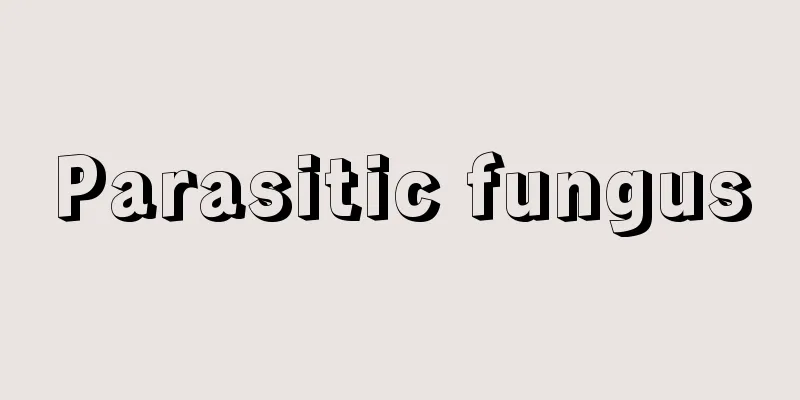Parasitic fungus

|
This refers to bacteria that are involved in biodecomposition, in other words, pathogenic bacteria. In the ecosystem, fungi play the role of reducers, that is, breaking down organic matter and reducing it to inorganic matter. When the subject of decomposition is dead matter, it is called necrotic parasitism or saprophysis, and is accompanied by the phenomenon of decay. When the subject of decomposition is living matter, it is called living parasitism, or parasitism in the narrow sense, and causes the phenomenon of disease. From the perspective of material circulation, the former is corpse decomposition and the latter is biodecomposition. Parasitic fungi are broadly divided into parasitic bacteria and parasitic fungi (molds and mushrooms). Bacteria often parasitize animals as hosts, while fungi often parasitize plants. Plant parasitic fungi are divided into three groups based on their parasitic nature (how they obtain nutrients and how they invade the host). The first group of parasitic fungi are extremely weak as pathogens, and can only invade if the host is extremely weakened for some reason, or if there is a wound or dead tissue. In contrast, the second group of parasitic fungi actively attacks the living cells of the host, depriving them of their vitality and invading. Therefore, they are strong pathogens, and some scholars call such fungi biocidal. There are many pathogens in the second group, such as the rice blast fungus and various anthracnose fungi, and they cause great damage to agricultural and forestry crops. However, both groups are necrotic parasitic on the host body, and even if the host is a living organism, they obtain nutrients from the cellular tissue that has lost its vitality. The difference between the two groups is whether or not the parasitic fungi actively create dead tissue to serve as a foothold for the pathogens. The third group of parasitic fungi invade the living cells of their host but do not kill them, instead obtaining nutrients from them. Therefore, if the host cell is defeated by the fungus' attack and dies, the fungus will also be deprived of nutrients and will be unable to continue living. These types of fungi are called obligate parasites, and representative examples include rust fungi, powdery mildew fungi, and dew mildew fungi. [Imaseki Rokuya] Source: Shogakukan Encyclopedia Nipponica About Encyclopedia Nipponica Information | Legend |
|
生体分解に関与する菌、すなわち病原菌をいう。菌類は生態系において還元者、つまり有機物を分解して無機物に還元するという役割を担う。分解の対象が死物の場合には死物寄生、または腐生といい、腐敗現象を伴う。分解の対象が生活体の場合には活物寄生、または狭義の寄生といい、病気という現象をおこす。これを物質循環の角度からみれば、前者は死体分解、後者は生体分解となる。寄生菌は寄生細菌と寄生真菌(カビとキノコ)に大別される。宿主としては、細菌は動物に、真菌は植物に寄生することが多い。 植物寄生菌は寄生性(栄養のとり方、宿主体への侵害性)によって次の3群に分けられる。第1群の寄生菌は、病原菌としてはきわめて弱いもので、宿主がなんらかの原因で著しく衰弱しているか、あるいは傷や死組織ができた場合に初めて侵入することができる。これに対して第2群の寄生菌は、宿主の生活細胞を積極的に攻撃し、その生活力を奪って侵略する。したがって病原菌としては強力で、このような菌を殺生(さっせい)菌という学者もある。イネのいもち病菌、各種炭疽(たんそ)病菌など第2群の病原菌は多く、農林作物に大きな被害をもたらす。しかし、第1、第2群とも宿主体上での栄養生活は死物寄生的で、宿主が生活体であっても、栄養は生活力を失った細胞組織から摂取する。両群の違いは、病原菌の足場となる死組織を寄生菌が積極的につくるか否かにある。 第3群の寄生菌は、宿主の生活細胞に侵入するが、宿主細胞を殺さず、生活細胞から栄養をとるものである。したがって、もし宿主細胞が菌の攻撃に敗れて死ぬと、菌も栄養を絶たれて生活を続けることができなくなる。このような菌を絶対的活物寄生菌といい、さび病菌類、うどんこ病菌、露菌(ろきん)病(べと病)菌などがこれを代表する。 [今関六也] 出典 小学館 日本大百科全書(ニッポニカ)日本大百科全書(ニッポニカ)について 情報 | 凡例 |
<<: Restricted area - Restricted area
Recommend
Shahti (English spelling) Шахты/Shahtï
A mining and industrial city in the Rostov Oblast...
Type printing - Katsuji Printing
A method of directly transferring the shape of cha...
Uyghur - Uyghur (English spelling)
A Turkic people who first migrated to the Mongolia...
Almoade - Almoade
…1130-1269. In Spanish, it is called Almohade. It...
Merritt, B.
... In terms of plays, the equivalent of Lawson i...
Smellie, W. (printer) (English spelling) Smellie W
…The first edition was published in three volumes...
solifluction lobe
...The formation of the stone pavement, which is ...
Transhumance - Iboku
A form of seasonal migration of pastoralists and ...
Podium
…Some people believe that the arch, which played ...
Karaku Province - Karaku
…A powerful state among the ancient Korean states...
Pomponia merula (English spelling) Pomponia merula
…[Masami Hayashi]. . … *Some of the terminology t...
Karyoshun
…The term was used by Gao Lian, a Chinese literat...
Kowalewski, G.
...The knight is a knight that can jump in any of...
Paal L. (English notation) PaalL
… In the mid-19th century, artists began to paint...
Bogota
…On April 9, 1948, the 9th Organization of Americ...









